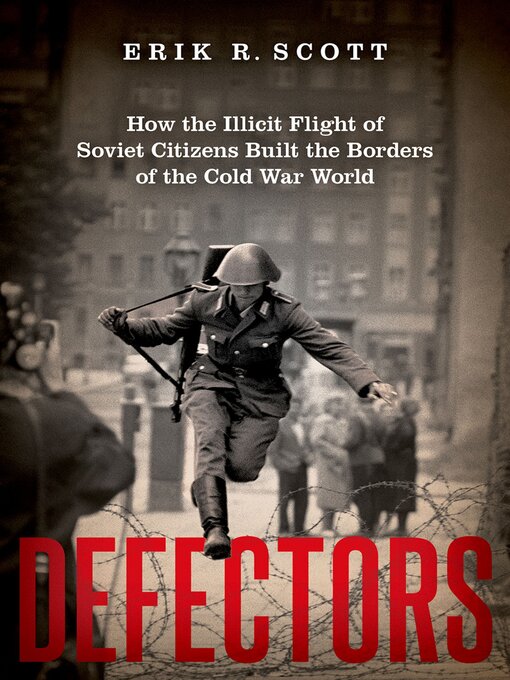- All Fiction
- Military Fiction
- Historical Fiction
- Mystery & Thriller
- Romance
- See all fiction collections
Defectors
How the Illicit Flight of Soviet Citizens Built the Borders of the Cold War World
-
Creators
-
Publisher
-
Release date
June 23, 2023 -
Formats
-
Kindle Book
-
OverDrive Read
- ISBN: 9780197546895
-
EPUB ebook
- ISBN: 9780197546895
- File size: 3071 KB
-
-
Languages
- English
-
Reviews
-
Library Journal
June 2, 2023
Since World War II, there has been a flow of Russians moving across borders that are constantly changing in permeability and risk. Center for Russian, East European, and Eurasian Studies Director Scott (history, Univ. of Kansas; Familiar Strangers: The Georgian Diaspora and the Evolution of Soviet Empire) distinguishes between migrants and defectors in order to clarify the postwar changes in who was considered a legitimate traveler and who posed a serious threat to the losing country. The term "defector" is a postwar political term to categorize political decisions made about migrants. Many often returned to their original country, and in the case of Russia, are generally welcomed back into the fold, often blurring the popular vision of searching for freedom vs. tyranny. VERDICT This diplomatic history is dense and detailed. Best suited for academic libraries with collections in modern European history.--Edwin Burgess
Copyright 2023 Library Journal, LLC Used with permission.
-
Kirkus
May 15, 2023
A densely researched examination of the defector program constructed in the West as a response to Soviet restriction of movement during the Cold War. The harboring of defectors from the Soviet Union in their "leap to freedom" was a tremendous coup for the West. However, as historian and Russian Review editor Scott shows in this multilayered academic study, it was also a delicate balancing act between the two Cold War powers. The right to seek asylum was affirmed in the 1948 U.N. Universal Declaration of Human Rights, and refugee protections were later detailed in the 1951 Geneva Convention. Although originally designated as those who fled from the Soviet Union and its Warsaw Pact allies, political defectors came to encompass migrants from China, Vietnam, Cuba, and elsewhere in the socialist world. The backgrounds of the defectors were diverse--from artist to sailor to politician to embassy administrator--and their cases often uneasily straddled the "political and ideological fault lines of the Cold War." In the U.S., the National Security Council created a defector program by the early 1950s, with the aim of selecting Soviet defectors who could be helpful in relaying intelligence information and whose stories of flight would aid the Cold War narrative of West versus East. However, not all defectors were welcome, nor did they have an easy time adjusting, and many even returned to the Soviet Union. Scott looks at many cases that were more complicated than that of Victor Kravchenko, "the Soviet official who fled while on assignment in Washington [and] published I Chose Freedom in 1946, just as the battle lines between the Cold War's superpowers were being drawn." Scott makes a strong argument that limiting border movement became an integral part of "globalization's architecture" and that "defectors were both the catalysts for the delimiting of previously open spaces and the most visible representatives of the consequences of enclosure." A nuanced look at deep complications underneath stories of asylum seekers in their journey "from tyranny to liberty."COPYRIGHT(2023) Kirkus Reviews, ALL RIGHTS RESERVED.
-
Publisher's Weekly
July 3, 2023
In this radical reassessment of U.S.-Soviet relations from 1944 to the U.S.S.R.’s collapse in 1991, historian Scott (Familiar Strangers) demonstrates how Washington and Moscow, through “self-interested acts of inter-imperial collusion,” regulated the defection of Soviet citizens to America. Citing declassified KGB records and other materials, Scott notes that American officials, under the 1951 Refugee Convention, encouraged the several million Soviet citizens displaced in Germany to seek asylum in the U.S., but also took measures to make sure only select defectors (mostly those with military and science backgrounds) were actually admitted. The Soviets, on the other hand, were determined to repatriate “nonreturners” and engaged in a massive tracking effort with diligent officials concocting schemes to lure individuals home, often enlisting family members still living in the U.S.S.R. to apply pressure. Scott relates in detail several high-profile defection cases—including the 1970 hijacking of a Soviet domestic passenger plane by a father and his 13-year-old son—to show how both superpowers contrived to control defection and regulate international spaces in their own national interests. He also suggests that Cold War–era stratagems, based on limiting human migration, are still in place and ill-serve peoples trying to escape the “slow violence” of climate change, deforestation, and other human-made disasters. Both seasoned Sovietologists and newcomers to Cold War history will find food for thought in this creative reevaluation of the era’s geopolitics.
-
Formats
- Kindle Book
- OverDrive Read
- EPUB ebook
subjects
Languages
- English
Loading
Why is availability limited?
×Availability can change throughout the month based on the library's budget. You can still place a hold on the title, and your hold will be automatically filled as soon as the title is available again.
The Kindle Book format for this title is not supported on:
×Read-along ebook
×The OverDrive Read format of this ebook has professional narration that plays while you read in your browser. Learn more here.



